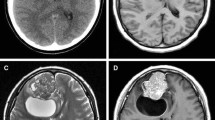Summary
The proliferative potential of neoplastic cells in two cases of gliomatosis cerebri was investigated by a combined staining technique, a one-step silver colloid method for nucleolar organizer region-associated protein (AgNOR) and immunohistochemistry for fibrillary acidic protein (GFAP). The neoplastic cells in the two cases had an abnormal shape and showed positive GFAP immunostaining in their cytoplasm. The numbers of AgNORs were counted in central and peripheral lesions of the neoplastic field in each case. The mean AgNOR scores in neoplastic cells were almost the same as those of nonneoplastic astrocytes in both the central and the peripheral lesions. These values were almost equal to the AgNOR score of low-grade gliomas. These findings indicate that gliomatosis cerebri has an invasive character in the central nervous system and often shows a malignant tendency, but its proliferative potential is significantly lower than that of high-grade gliomas.
Similar content being viewed by others
References
Artigas J, Cervos-Navarro J, Iglesias JR, Ebhardt G (1985) Gliomatosis cerebri: clinical and histological findings. Clin Neuropathol 4:135–148
Couch JR, Weiss SA (1974) Gliomatosis cerebri: report of four cases and review of the literature. Neurology 24:504–511
Crocker J, Nar P (1987) Nucleolar organizer regions in lymphomas. J Pathol 151:111–118
Egan MJ, Raafat F, Crocker J, Smith K (1988) Nucleolar organizer regions in fibrous proliferations of childhood and infantile fibrosarcoma. J Clin Pathol 41:31–33
Gerdes J, Schwab U, Lemke H, Stein H (1983) Production of a mouse monoclonal antibody reactive with a human nuclear antigen associated with cell proliferation. Int J Cancer 31:13–20
Geremia GK, Wollman R, Foust R (1988) Computed tomography of gliomatosis cerebri. J Comput Assist Tomogr 12:698–701
Gratzner HG (1982) Monoclonal antibody to 5-bromo- and 5-iododeoxyuridine: a new reagent for detection of DNA replication. Science 218:474–475
Hall PA, Levison DA (1990) Review: assessment of cell proliferation in histological material. J Clin Pathol 43:184–192
Hara A, Hirayama H, Sakai N, Yamada H, Tanaka T, Mori H (1990) Correlation between nucleolar organizer region staining and Ki-67 immunostaining in human gliomas. Surg Neurol 33:320–324
Lischwe MA, Smetana K, Olson MOH, Busch H (1979) Proteins C23 and B23 are the major silver staining proteins. Life Sci 25:701–708
Nevin S (1938) Gliomatosis cerebri. Brain 61:170–191
Ochs RL, Busch H (1984) Further evidence that phosphoprotein C23 (110 kD pH 5.1) is the nucleolar silver staining protein. Exp Cell Res 152:260–265
Ploton D, Menager M, Jeannesson P, Himber G, Pigeon F, Adnet JJ (1986) Improvement in the staining and visualization of the argyrophilic proteins of the nucleolar organizer region at the optical level. Histochem J 18:5–14
Reuschoff J, Plate K, Bittinger A, Thomas C (1989) Nucleolar organizer regions (NORs): basic concepts and practical application in tumor pathology. Pathol Res Pract 185:878–885
Schmidbauer M, Meuller C, Podreka I, Mamoli B, Sluga E, Deecke L (1989) Diffuse cerebrospinal gliomatosis presenting as motor neuron disease for two years. J Neurol Neurosurg Psychiatry 52:275–278
Spagnoli MV, Grossman RI, Packer RJ, Hackney DB, Goldberg HI, Zimmerman RA, Bilaniuk LT (1987) Magnetic resonance imaging determination of gliomatosis cerebri. Neuroradiology 29:15–18
Tanaka T, Takeuchi T, Nishikawa A, Takami T, Mori H (1989) Nuclear organizer regions in hepatocarcinogenesis induced by N-2-fluorenylacetamide in rats: comparison with immunohistochemistry using a monoclonal antibody against bromodeoxyuridine. Jpn J Cancer Res 80:1047–1051
Williams MA, Kleinschmidt JA, Krohne G, Franke WW (1982) Argyrophilic nuclear and nucleolar proteins of Xenopus laevis oocytes identified by gel electrophoresis. Exp Cell Res 137:341–351
Wilson NW, Symon L, Lantos PL (1987) Gliomatosis cerebri: report of a case presenting as a focal cerebral mass. J Neurol 234:445–447
Author information
Authors and Affiliations
Rights and permissions
About this article
Cite this article
Hara, A., Sakai, N., Yamada, H. et al. Assessment of proliferative potential in gliomatosis cerebri. J Neurol 238, 80–82 (1991). https://doi.org/10.1007/BF00315685
Received:
Revised:
Accepted:
Issue Date:
DOI: https://doi.org/10.1007/BF00315685




